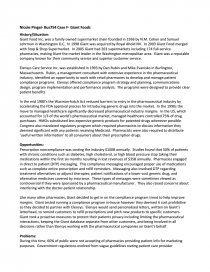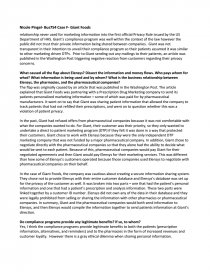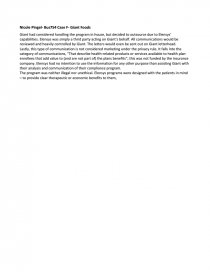Giant Food Inc. V Elensys Care Service Inc Case
Essay by Nicole Pingel • June 24, 2015 • Case Study • 2,206 Words (9 Pages) • 4,037 Views
Essay Preview: Giant Food Inc. V Elensys Care Service Inc Case
History/Situation:
Giant Food Inc. was a family owned supermarket chain founded in 1936 by N.M. Cohen and Samuel Lehrman in Washington D.C. In 1998 Giant was acquired by Royal Ahold NV. In 2003 Giant Food merged with Stop & Shop Supermarket. In 2005 Giant had 203 supermarkets including 174 full-service pharmacies, making Giant the market leader in the Washington metropolitan area. Giant was a reputable company known for their community service and superior customer service.
Elensys Care Service Inc. was established in 1993 by Dan Rubin and Mike Evanisko in Burlington, Massachusetts. Rubin, a management consultant with extensive experience in the pharmaceutical industry, identified an opportunity to work with retail pharmacies to develop and manage patient compliance programs. Elensys offered compliance program strategy and planning, communications design, program implementation and performance analysis. The programs were designed to provide clear patient benefits
In the mid 1980’s the Waxman-hatch Act reduced barriers to entry in the pharmaceutical industry by accelerating the FDA approval process for introducing generic drugs into the market. In the 1990s the move to managed healthcare significantly decreased pharmaceutical industry margins. In the US, which accounted for 1/3 of the world’s pharmaceutical market, managed healthcare controlled 75% of drug purchases. HMOs substituted less expensive generic products for patented drugs whenever possible. Congress also mandated regulatory program which required pharmacists to discuss information they deemed significant with any patients receiving Medicaid. Pharmacists were also required to distribute ‘useful written information’ to all consumers about their prescription drugs.
Opportunities:
Prescription noncompliance was costing the industry $100B annually. Studies found that 50% of patients with chronic conditions such as diabetes, high cholesterol, or high blood pressure stop taking their medications within the first six months resulting in lost revenues of $35B annually. Pharmacies engaged in direct to patient (DTP) messaging. This compliance messaging encouraged proper use of medications such as complete entire prescription and refill reminders. Messaging also involved DTP regarding treatment alternatives or adjunct therapies; patient notifications of a lower-cost generic drug, and alternative medicines covered by insurance. These types of messages were sometimes viewed as controversial if they were sponsored by a pharmaceutical manufacturer. They also raised concerns about interfering with the doctor-patient relationship.
Like many other pharmacies, Giant decided to get in on the compliance program trend to help improve margins. Giant tested running a compliance program in-house however they deemed it cost prohibitive so they decided to partner with Elensys. Elensys would send personalized letters, written on Giant’s letterhead, to remind customers to refill prescriptions and pitch new products to specific customers. Giant took a proactive measures to protect their patients privacy including limiting the pharmaceutical interactions, keeping the Giant database separate from other customers, and being involved in all decisions rather than Elensys working with the pharmaceutical companies on Giant’s behalf.
Problems:
During this time, 60% of public were not accepting of pharmacies providing patient info for marketing purposes. Government regulations evolved from vague guidelines stating patient care provider relationship never used for marketing information into the first official Privacy Rule issued by the US Department of HHS. Giant’s compliance program was well within the context of the law however the public did not trust their private information being shared between companies. Giant was not transparent in their intention to unveil their compliance program so their patients assumed it was similar to other marketing driven DTPs. Prior to Giant sending out any mailings to their patients, an article was published in the Washington Post triggering negative reaction from customers regarding their privacy concerns.
What caused all the flap about Elensys? Dissect the information and money flows. Who pays whom for what? What information is being used and by whom? What is the business relationship between Elensys, the pharmacies, and the pharmaceutical companies?
The flap was originally caused by an article that was published in the Washington Post. The article explained that Giant Foods was partnering with a Prescription Drug Marketing company to send its patients personalized marketing information – some of which was paid for by pharmaceutical manufacturers. It went on to say that Giant was sharing patient information that allowed the company to track patients that had not refilled their prescriptions, and went on to question whether this was a violation of patient privacy.
In the past, Giant had refused offers from pharmaceutical companies because it was not comfortable with what the companies wanted to do. For Giant, their customer was their priority, so they only wanted to undertake a direct to patient marketing program (DTP) if they felt it was done in a way that protected their customers. Giant chose to work with Elensys because they were the only independent DTP marketing company that was not funded by a major pharmaceutical company. In addition, Giant chose to negotiate directly with the pharmaceutical companies so that they alone had the ability to decide what would be sent to each patient. Because of this, pharmaceutical companies would pay Giant for their negotiated agreements and then Giant would pay Elensys for their marketing services. This was different than how some of Elensys’s customers operated because those companies used Elensys to negotiate with pharmaceutical companies on their behalf.
In the case of Giant Foods, the company was cautious about creating a secure information sharing system. They chose not to provide Elensys with their entire customer database and Elensys’s database was set up for the privacy of the customer as well. It was broken into two parts – one that had the patient’s personal information and one that had a patient’s prescription and analysis information. These two parts were linked together by a customer ID number. Elensys did not own any of the data in their database and they were legally prohibited from selling or sharing the information with other pharmacies or pharmaceutical companies. In summary, Giant and the pharmaceutical companies would both send information to Elensys, and then Elensys would compile the information together to send patients information at Giant’s direction.
...
...




